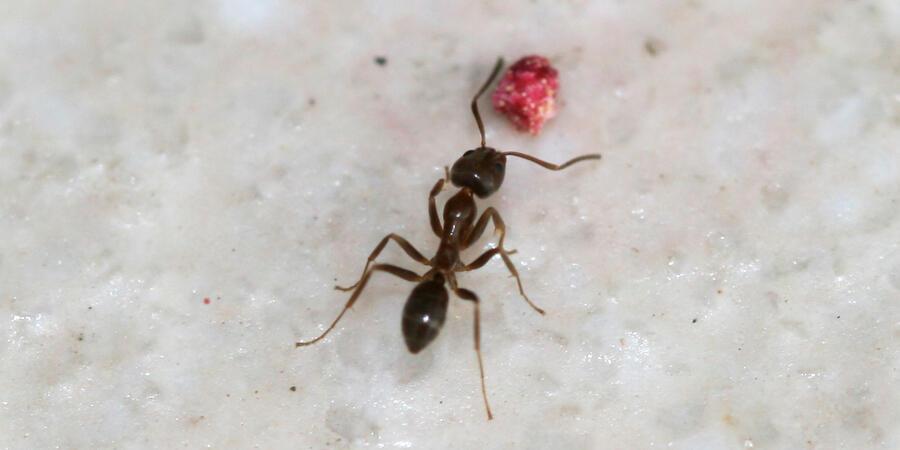This article was written by fourteen-year-old Oisin Wagstaff-Dent from Bishop Challoner Catholic College in Birmingham as part of the Association of British Science Writers Young Science Writer of the Year Award competition supported by the BBC and the Ri.
Ants: known to be one of the most serious global invasive species. Their varied diets, nesting habitats and ability to adapt to given environments allow them to invade all parts of the world, making them a considerate biosecurity threat to social, economic and environmental aspects of human agriculture. One ant species among the 16,000 known have been the most hazardous to societies: The Argentine ant (Linepithema humile)
Native to central South America, the wingless worker ant is 2-3 millimetres long and a shade of brown, whilst the queen and males are larger and darker. Argentine ants are identified by their: five to eight large teeth like mandibles, twelve segmented antennae, singular node separating the hind body segments, smooth body surface with a lack of hair/presence of a stinger. [2]
Being able to establish colonies with as little as 10 workers and 1 queen, paired with their ability to endure long journeys and the fact queens can lay up to 60 eggs a day, has allowed them to pervade all 7 continents. [2]

Typically, species would not benefit from genetic similarity; however, Argentine ants are able to remain distant cousins as opposed to enemies, which was the case in their native region of South America. As colonies migrated and evolved, they grew genetically different and fought each other over territory, nutrients and energy. These “wars” resulted in a decline of population until they migrated from South America and developed genetic similarity, allowing them to reproduce rapidly without conflict within themselves. [3]
A threat to ecosystems and agriculture alike, Argentine ants displace rival colonies and species through mass of numbers in their “super colonies”. Even secondary and tertiary consumers have had their population decline in the presence of Argentine ants. One case study [4] even shows that the presence of Argentine ants have a negative effect on coast horned lizards (Phoynosoma coronatum) and shrews (Notiosorev crawferdi), both of which are secondary consumers.
Directly and indirectly detrimental to the wellbeing of crops, Argentine ants are known to replace 90% of ant species wherever they invade [2]. In many instances, this species has displaced and replaced harvester ants, which share a mutualistic interaction with plants and farmers; harvester ants are beneficial to the spread range and density of plants via spreading seeds, aerating the soil and protecting them against potential predators, such as aphids (small, sap-sucking insects) [5]. But they also act as a biological control agent to wheat by feeding on them; this saves fuel and labour costs for farmers having to till the farm[5].

However, Argentine ants protect aphids, [1] who feed on crops, as aphids produce a sweet substance the species adore. Aphids have also been noted to spread diseases and famine with them as they travel from fields. This hinders crop’s yield and henceforth prevents farmers from making profit in their field, as they cannot sell as much good quality crops.
In addition to the already overwhelming economical drawbacks farmers face from Argentine ants, money has to be spent, diverted or reserved in order to: replace irrigation pipes as Argentine ants chew through them in order to access water. Build safer pens for chickens, hatchlings and eggs that are being slain and producing or buying insecticides to reduce population numbers of super colonies. [1]
Moreover, urban citizens have suffered in the presence of Argentine ants, needing to repair damaged house infrastructure. Due to super colonies inhabiting nearby land areas, children are prevented from playing outside, town meetings have to be withdrawn and even residents are moving away for fear of repairs being greater than simply migrating. When Argentine ants detect a possible threat, they attack in swarms and can possibly bite their target; despite one on their own not holding much of a threat, masses can extremely injure someone, causing these measures to have to be taken. Additionally, Argentine ants are capable of invading closed cupboards to sealed jars, and once they have entered homes, they have proven themselves proficient at killing household pets like lizards and birds. [1]
Despite the threat Argentine ants pose, society has been able to advance and diminish the hazards of Argentine ants. One way to do this is through Genetic modification; in this case, genetically modified crops can produce a toxin that acts as a liquid pesticide when the crop is penetrated by aphids or the ants. For example, Bacillus thuringiensis, known as “Bt toxin”, was genetically modified into corn so that aphids and other pests could not harm the crop and therefore the corn yielded more. However, genetic modification is quick but only accessible to richer farmers, meaning it is not globally available.
In conclusion, Argentine ants pose a serious threat to the agricultural aspect of society globally and very little can be done to prevent them causing devastation.

About the award
The Young Science Writer of the Year Award is designed to get students aged 14-16 thinking and writing about the big questions in science, technology, engineering and maths, at a time when the rise of misinformation and dis-information, which is disproportionately consumed online by young people, is of increasing concern to children’s charities worldwide.
Read more essays from the competition:
Refrences
1. https://argentineants.landcareresearch.co.nz/impacts.asp#:~:text=Social…
2. http://www.columbia.edu/itc/cerc/danoff-burg/invasion_bio/inv_spp_summ/…
3. https://askentomologists.com/2015/07/13/why-do-argentine-ants-from-geor…
4. “Prey selection In Horned Lizards following the invasion of Argentine Ants in South America”(Andrew V. Suarez, Jon Q. Richmond, Ted J. Case)
5. https://www.eurekalert.org/news-releases/576600#:~:text=Harvester%20ant….